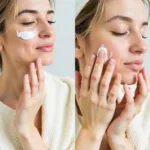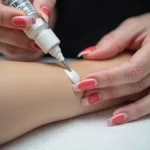Dermaplaning with a Tinkle Razor: A Comprehensive Guide
- AmazoniaSilva
- Tháng 1 12, 2025
- Zodiac signs
- 0 Comments
Dermaplaning with a Tinkle razor has taken the beauty world by storm, offering a simple and affordable way to achieve smooth, glowing skin. This guide explores everything you need to know about this popular exfoliation method, from its benefits and risks to how to do it safely and effectively at home.
What is Dermaplaning with a Tinkle Razor?
Dermaplaning involves using a single-blade razor, like the popular Tinkle razor, to gently scrape away dead skin cells and vellus hair (peach fuzz) from the face. It’s a physical exfoliation method that can leave your skin feeling incredibly soft and smooth, creating a perfect canvas for makeup application. This technique also helps skincare products penetrate deeper, maximizing their effectiveness. While it might sound intimidating, dermaplaning with a Tinkle razor is generally safe and easy to do at home with the right precautions.
Benefits of Dermaplaning with a Tinkle Razor
Dermaplaning with a Tinkle razor offers a range of benefits, including:
- Removal of Peach Fuzz: This gives your skin a noticeably smoother texture and brighter appearance.
- Exfoliation of Dead Skin Cells: This promotes cell turnover, revealing fresh, radiant skin.
- Improved Skincare Product Absorption: Removing the barrier of dead skin and hair allows your serums and moisturizers to penetrate more deeply.
- Enhanced Makeup Application: A smooth skin surface provides a flawless base for makeup, allowing it to glide on evenly and last longer.
- Minimized Appearance of Fine Lines and Wrinkles: While not a permanent solution, dermaplaning can temporarily reduce the appearance of fine lines by removing the dead skin that can accentuate them.
How to Dermaplaning with a Tinkle Razor at Home
Follow these steps for safe and effective dermaplaning at home:
- Cleanse: Thoroughly cleanse your face with a gentle cleanser to remove makeup and dirt.
- Dry: Pat your skin completely dry.
- Hold Skin Taut: Hold a section of skin taut with one hand.
- Angle the Razor: Hold the Tinkle razor at a 45-degree angle against your skin.
- Short Strokes: Use short, gentle, downward strokes to glide the razor across your skin. Avoid applying too much pressure.
- Rinse: After completing each section, rinse the razor.
- Moisturize: Once finished, apply a hydrating serum or moisturizer.
- Sunscreen: Always follow up with sunscreen, as dermaplaning can make your skin more sensitive to the sun.
Potential Risks and Precautions
While generally safe, dermaplaning with a Tinkle razor does come with potential risks if not performed correctly. These include:
- Cuts or Nicks: Be cautious, especially around sensitive areas like the eyes and lips.
- Irritation: Some people may experience redness or irritation, particularly those with sensitive skin.
- Infection: Ensure your razor is clean and avoid using it on active breakouts.
“Dermaplaning can be an effective exfoliation method,” says Dr. Emily Carter, a board-certified dermatologist. “However, it’s essential to follow proper technique and hygiene to minimize the risk of complications.”
Dermaplaning for Different Skin Types
- Sensitive Skin: Proceed with caution and consider patch testing a small area first.
- Acne-Prone Skin: Avoid dermaplaning over active breakouts, as it can spread bacteria.
- Dry Skin: Follow up with a rich moisturizer to hydrate the skin.
Conclusion
Dermaplaning with a Tinkle razor can be a valuable addition to your skincare routine, offering smooth, radiant skin and enhanced product absorption. By following the correct techniques and precautions outlined in this guide, you can safely enjoy the benefits of this popular at-home treatment. Remember to prioritize skin health and consult a dermatologist if you have any concerns.
FAQ
- Does dermaplaning make hair grow back thicker? No, it doesn’t. Vellus hair grows back at the same rate and thickness.
- How often should I dermaplane? Every 3-4 weeks, depending on your skin’s needs.
- Can I dermaplane if I have active acne? No, avoid dermaplaning over active breakouts.
- Is dermaplaning painful? No, it’s generally painless.
- What should I do if I cut myself? Apply gentle pressure to stop the bleeding and disinfect the area.
- Can I dermaplane if I’m pregnant? Consult your doctor before dermaplaning while pregnant.
- What’s the difference between dermaplaning and shaving? While both use a blade, dermaplaning uses a specific blade designed for exfoliation.
For further assistance, please contact us at Email: [email protected], or visit our office at Fifth Avenue, 34th Floor, New York, NY 10118, USA. We have a 24/7 customer service team ready to help.

